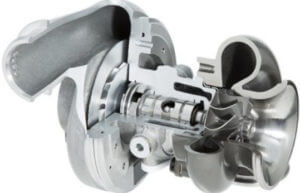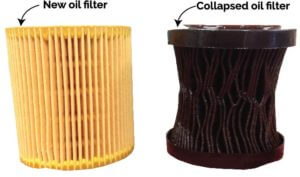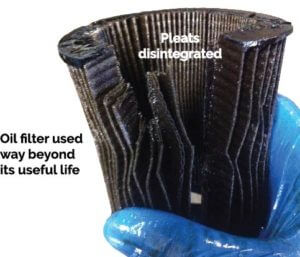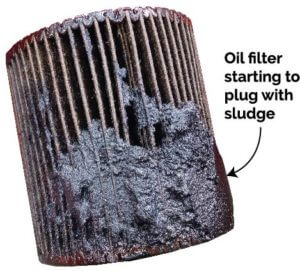How often to change oil in your car or truck
How often to change oil in your car
How often to change oil is all there in your owner’s maintenance guide
Auto engineers aren’t stupid. They’ve tested their engines and oil and then know how long oil lasts. So the owner’s maintenance guide lists to change intervals; one for normal service and one for severe service. If you want to know whether your driving qualifies for normal or severe service, see this article.
Here are the factors that determine when to change oil
1) Which engine do you have? What year?
Engineers determine what type of oil an engine needs and how long it can last based on the engine’s design. For example: An engine with a turbo creates more heat, which is harder on oil than  the same engine without a turbo. The turbo spins at speeds up to 100,000 RPM. That generates a lot of heat that can break down oil much faster than an engine that doesn’t have a turbo. Some engines with turbos have an oil change interval of just 3,750 miles while the same engine without a turbo can go up to 7,000 miles. If someone gave you advice to change your oil every 10,000 miles on a vehicle with a turbo, you could easily destroy your engine and be looking at a $4,000 repair bill. In addition, engines with variable valve timing (VVT) (most late model engines) alter camshaft timing by pulsing oil pressure to a hydraulic unit that rotates the camshaft slightly. Pulsing oil under pressure can cause it to foam, so the oil’s anti-foaming additives are depleted faster.
the same engine without a turbo. The turbo spins at speeds up to 100,000 RPM. That generates a lot of heat that can break down oil much faster than an engine that doesn’t have a turbo. Some engines with turbos have an oil change interval of just 3,750 miles while the same engine without a turbo can go up to 7,000 miles. If someone gave you advice to change your oil every 10,000 miles on a vehicle with a turbo, you could easily destroy your engine and be looking at a $4,000 repair bill. In addition, engines with variable valve timing (VVT) (most late model engines) alter camshaft timing by pulsing oil pressure to a hydraulic unit that rotates the camshaft slightly. Pulsing oil under pressure can cause it to foam, so the oil’s anti-foaming additives are depleted faster.
2) How often do you start your engine when it’s cold?
Engines require more gas to start when cold because the cold metal “quenches” the flame faster. When the combustion is quenched some of the gas doesn’t get burned. A small portion of that unburned fuel bypasses around the piston rings and winds up in the engine’s crankcase, where it mixes with the oil. The gas dilutes the oil and stresses the additives, wearing them out faster.
3) Do you have a lead foot?
Multi-viscosity oil incorporates a thickening agent to prevent the oil from thinning out too much as it accumulates heat. The thickening agent is called a viscosity improver (VI). It’s actually a polymeric molecule that’s coiled when cold and uncoils as it heats up. It’s almost like adding flour to gravy to thicken it, except that this product is reversible.
Unfortunately, VI doesn’t lubricate—it just adds bulk to the oil. So when it’s forced through small opening or compressed during heavy acceleration, the molecules can “shear”—get cut in half (picture a meat grinder). As more molecules shear, the oil loses its ability to thicken when hot. Thin oil squirts out between rotating metal components, lowering the oil’s ability to lubricate and separate metal parts.
Once VI starts to shear, the shearing process snowballs. So putting the pedal to the metal actually damages your oil. If you’re a lead foot, you should change your oil more often.
4) How often do you check oil level and top it off?
All engines burn oil—even new ones right out of the factory. Running an engine while it’s low on oil wasn’t as big a deal back when conventional oil was used and you changed it every 3,000 miles. Most engines didn’t burn very much oil during the time. But newer engines filled with synthetic oil can sometimes run as long as 10,000 miles. Chances are you’ll burn almost a quart of oil during that period of time. If your engine is filled with four quarts and you burn off a quart, you dramatically reduce the additives in the remaining three quarts. Even if the vehicle is equipped with an oil life monitoring system, that system assumes you’ve been checking the oil level and adding more oil to compensate for the burned oil. It doesn’t know that you’re driving around while a quart low. . If you’re not checking your oil and adding more when it’s low, then you can’t depend on the oil life monitor to give you an accurate result. Running an engine while low on oil stresses the remaining oil so much that you’re actually damaging your engine.
5) Does your engine have a high quality oil filter?
Before synthetic oil was introduced, oil filters were built to last only 3,000 miles.  Oil filter manufacturers used one of only eight different types of filter papers. That’s changed quite a bit with the newer engines and synthetic oil. Today oil filter manufacturers used over 80 different types of filter media and the type of filter media is engine specific. However, there are still some oil filter manufacturers that make the old inexpensive paper filters and they sell them in bulk to the quick oil change places.
Oil filter manufacturers used one of only eight different types of filter papers. That’s changed quite a bit with the newer engines and synthetic oil. Today oil filter manufacturers used over 80 different types of filter media and the type of filter media is engine specific. However, there are still some oil filter manufacturers that make the old inexpensive paper filters and they sell them in bulk to the quick oil change places.
Those older filters deteriorate at around 3,000 miles. Or, they load up with  contaminates and go into “by-pass” mode where the oil no longer circulates through the filter media, but goes around it instead. In those cases you may think you’re protected when you’re not.
contaminates and go into “by-pass” mode where the oil no longer circulates through the filter media, but goes around it instead. In those cases you may think you’re protected when you’re not.
You can count on the car dealer to install the correct filter. And most independent shops also install a filter that’s rated for extended service. It’s the quick change oil places that you have to worry about. Even if they talk you into switching to synthetic oil, chances are good that they’ll install an inexpensive paper filter that won’t last as long as the oil.
for extended service. It’s the quick change oil places that you have to worry about. Even if they talk you into switching to synthetic oil, chances are good that they’ll install an inexpensive paper filter that won’t last as long as the oil.
Can you trust the oil life monitoring system?
Late model cars come with oil life monitoring systems. In the early days of oil life lights, they simply monitored the miles you drove. The newer ones are a bit smarter. The computer counts the number of times you’ve started the engine when cold, how you drive it as it’s warming up, how far you drive it before shutting down, and whether you do lots of stop and go driving. Based on an internal algorithm, it determines how much of the additive package is left in your oil. But I haven’t quite answered the question—can you the oil life monitoring system. Well, no.
First, the oil life monitoring system must assume you’ve used the correct oil and filter at the last oil change. That means you must install an oil that meets the car makers specifications (not all oil does) and that you’ve used a premium oil filter rated to last as long as specified. If you get your oil changed at a quick change oil place, you cannot assume either of those things.
Next, the oil life monitoring system assumes you check the oil level in your engine and top it off with the correct oil when it runs low. When was the last time you checked the oil level in your engine and topped it off? I didn’t think so.
Finally, the oil life monitoring system doesn’t actually have a sensor to determine the oil life. It’s a mathematical algorithm, which means it’s based on assumptions. Many car makers have been forced to reprogram their software to compensate for overly optimistic assumptions built into the original oil life software. And, many car makers have had to pay for very expensive repairs because their oil life monitoring systems were off by quite a bit.
Since major engine work can easily cost $2,000 to $3,000 it doesn’t make sense to run your engine all the way to the end of the projected oil life. It’s just too risky.
What is severe service?
Your maintenance guide will give different oil change intervals for different types of driving. Most drivers fit into the severe service category. See the severe service definitions below:
If you drive your vehicle mainly under one or more of the following conditions:
• Driving less than 5 miles per trip or in freezing temperatures.
• Driving less than 10 miles per trip.
• Driving in hot (over 90°F) conditions.
• Extensive idling or long periods of stop-and-go driving.
• Driving with a rooftop carrier, or driving in mountainous conditions.
• Driving on muddy, dusty, or de-iced roads.
Don’t trust self-proclaimed experts
In order to give you an accurate estimate of how long you can drive between oil changes, any advisor must know how you drive, how long you drive, where you get your oil and oil filter, and whether you check the engine oil level between changes. If they don’t ask that information before giving you an estimated oil change rate, then they don’t know anything about oil.
©, 2016 Rick Muscoplat
Posted on by Rick Muscoplat
